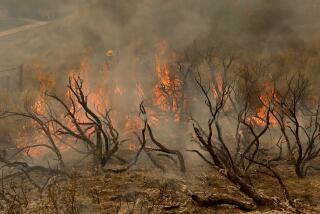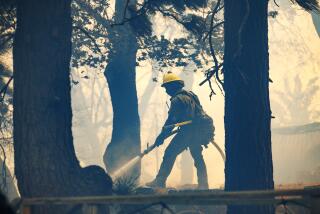Weary Carson City Hopes the Worst Is Over
CARSON CITY, Nev. — When American Airlines pilot Hugh Fenwick last saw his 4,400-square-foot house in the mountains above the state capital, he was running from flames racing down a canyon.
Fenwick returned Friday morning to find the rubble of his dream home.
“Here was my front door,” said Fenwick, 37. “Total destruction. But you know, the only important thing about this is that nobody died. I can always rebuild the house -- and I will.”
The fire that took Fenwick’s home was still raging Friday, having consumed about 7,600 acres and destroyed 14 homes. Officials warned that the unpredictable winds that had whipped the fire into a fury this week could drive it once again into the affluent subdivisions along the western ridges of the city. But the winds remained calm for much of Friday, giving firefighters optimism that the worst was behind them.
“We had a real good day today,” said Kim Martin, commander for the Great Basin firefighting team.
A heavy blanket of smoke and ash hung over Carson City, leaving homes and offices reeking with the stench of burning brush.
Federal officials have ranked the blaze, known as the Waterfall Fire, as the highest-priority wildfire now burning in the Lower 48 states.
Dozens of pieces of heavy equipment, plows, aircraft, tankers, pumping trucks and buses have been moved into the city, and about 1,500 firefighters from across the West are helping battle the blaze.
At one point Thursday, it looked as though the fire could sweep into the center of the city and threaten state office buildings.
An operations center for emergency personnel has been set up at a high school, with pallets of drinks, food and fire-retardant clothing being made available in the parking lot. One classroom has been turned into a communications center; there is a records operation in another classroom and an emergency shelter for evacuees in the gym.
The kind of devastation seen in what officials have described as the most destructive wildfire in Nevada history is becoming commonplace throughout the West, which has endured six years of drought.
The dry vegetation here, a mix of desert brush and small pines, makes for an explosive mix. Humidity was in the single digits Friday, and high temperatures have left Carson City vulnerable.
At the same time as Nevada has been coping with drought, it has undergone explosive population growth. Subdivisions are pushing deeper into the desert scrub, placing homes next to highly combustible brush.
The changes are forcing the Nevada Division of Forestry to develop firefighting plans so detailed that in many cases state officials are planning how they would defend each house, said Rich Harvey, a resource program coordinator.
Each year, Nevada wildfires burn about 700,000 acres. In the past, such fires have typically burned in unpopulated tracts.
Not any more.
Carson City has attracted retirees and refugees from Los Angeles, San Francisco and other large cities -- people attracted by affordable custom homes on large lots in a state with low taxes.
But with climate experts warning that the West could be entering a period of long-term drought conditions, major events like the Carson City fire could become more routine.
“We have a problem, and we better get used to it,” Harvey said.
Early Friday morning, a hot spot sent a column of gray smoke several thousand feet into the sky, threatening another destructive day. City officials arranged a community meeting, which attracted several hundred residents.
“If somebody asked me to describe a worst case for a wildfire here, this fire would be it,” Stacey Giomi, acting Carson City fire chief, told the crowd assembled in an auditorium. “It is just amazing that we haven’t lost more homes.
“The scary thing is that what we are going through is going to happen 100 times a year in the West.”
Sheriff’s investigators said the fire was caused by humans, but have not yet determined whether it was intentionally set. The blaze was reported before dawn Wednesday, and city fire crews responded within seven minutes. But it was already too hot to contain.
By Friday afternoon, the fire was 50% contained, but that did not mean crews could stop it from advancing if winds shifted.
The highest priority, officials said, was to prevent the fire from moving over the western ridge that separates Carson City from the Lake Tahoe basin. Such an event would bring the fire into an area with even more combustible fuel and higher-priced homes.
The fire and hundreds like it across the West are unlikely to deter population growth, federal officials said.
Fenwick said his insurers are making arrangements to cover his losses. And he plans to rebuild on the same lot, with its commanding views of the city.
But Friday morning, Fenwick was sifting through the still-smoldering rubble for a watch that his wife had given him. His wife, a flight attendant on a trip to Cincinnati, broke out in tears when he called with the news.
More to Read
Sign up for Essential California
The most important California stories and recommendations in your inbox every morning.
You may occasionally receive promotional content from the Los Angeles Times.











